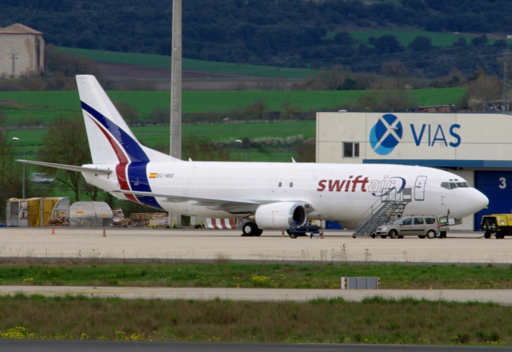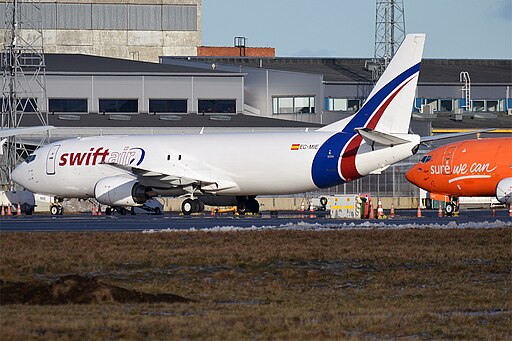
ASN Wikibase Occurrence # 274264
This information is added by users of ASN. Neither ASN nor the Flight Safety Foundation are responsible for the completeness or correctness of this information.
If you feel this information is incomplete or incorrect, you can submit corrected information.
| Date: | Wednesday 16 June 2021 |
| Time: | 01:04 UTC |
| Type: |  Boeing 737-4Y0 (SF) |
| Owner/operator: | Swiftair |
| Registration: | EC-MIE |
| MSN: | 26069/2352 |
| Year of manufacture: | 1992 |
| Fatalities: | Fatalities: 0 / Occupants: 2 |
| Aircraft damage: | Minor |
| Location: | East Midlands Airport (EMA/EGNX) -
 United Kingdom United Kingdom
|
| Phase: | Taxi |
| Nature: | Cargo |
| Departure airport: | East Midlands Airport (EMA/EGNX) |
| Vitoria Airport (VIT/LEVT) | |
| Confidence Rating: |
AAIB investigation to Boeing 737-4Y0F, EC-MIE: Aircraft taxied over towbar, East Midlands Airport, Leicestershire, 16 June 2021. The AAIB report into the incident was published on 13 January 2022, and the following is an excerpt from it...
"The aircraft was on a cargo flight from East Midlands Airport, Leicestershire, to VitoriaAirport, Spain. It was parked on Stand 99, on the West Apron. This is a ‘nose-in’ stand which requires a pushback prior to taxi. The ground crew in attendance for the pushback were a headset operative (HO) and a tug driver (TD). At the time, it was night.
The pushback and start up were uneventful. Once the pushback was completed the HO placed a chock in front of the nosewheel, to prevent the aircraft from moving, while the towbar and the HO’s headset were disconnected. It is the HO’s last task and responsibility to remove the chock and hand it to the TD, who places it in a basket on the tug, before walking off the taxiway. At this time the commander informed the HO that he was cleared to disconnect, and he would await the ‘visual clearance’, with the nosewheel steering bypass pin, on the right side of the aircraft.
Upon clearance from the HO, the TD reversed the tug slightly to allow the HO to disconnect the towbar from the tug. The HO then disconnected the towbar from the aircraft, removed the bypass pin and disconnected his headset. The TD turned the tug around and exited to re-connect the towbar to the rear of the tug, positioning the towbar on top of the rear attachment on the tug. However, before he secured it to the tug with a drop-in pin, he noticed that the HO was walking away from the aircraft with the chock still in front of the nosewheel.
This was recorded on CCTV. The TD left the towbar on top of the attachment, went to the nosewheel, removed the chock and placed it in the basket on the tug. He then re-entered the tug and drove off the taxiway to collect the HO, without connecting the towbar to the tug. The towbar remained on the taxiway in front of the aircraft. Once the HO had given the crew the visual clearance, he entered the tug and the TD drove them to the towbar parking area, before the aircraft started to taxi, but without checking the taxiway was clear.
The crew received clearance from ATC to taxi towards Runway 27. Soon after the aircraft started to move, the co-pilot felt something similar to the toe brakes being applied momentarily. Upon asking the commander if he had checked the brakes, the commander said he had not. They did not see the towbar under the aircraft’s nose prior to commencing the taxi
After the tug arrived at the towbar parking area, the HO got out to disconnect the towbar to discover it was not attached. Upon informing the TD he immediately drove back to Stand 99, without the HO, entering the taxiway without permission, and found the towbar in the taxiway with damage indicating that the aircraft had taxied over it. The TD immediately informed ATC and his supervisor, who informed airfield operations.
Whilst the aircraft was waiting to depart at the holding point for Runway 27, ATC informed the crew that there had been an incident during the pushback and an inspection of the aircraft was required. Subsequently, they were informed by the handling agent that the aircraft had struck something and they should return to a stand for an inspection. The aircraft was subsequently taxied back towards the East Apron, stopped, shutdown and towed onto a stand, where it was inspected.
Upon inspection, damage was discovered to the two tyres on the left landing gear. The damaged tyres were replaced before the aircraft departed after a delay of nearly four hours".
=Damage sustained to airframe=
Per the above AAIB report "Damage to towbar and two landing gear tyres"
Sources:
1. AAIB Final Report: https://assets.publishing.service.gov.uk/media/61bb30ade90e07043c35f651/Boeing_737-4Y0F_EC-MIE_01-22.pdf
2. https://www.flightglobal.com/safety/crew-of-737-freighter-taxied-over-towbar-left-by-distracted-ground-handlers/147110.article
3. http://www.b737.org.uk/accident_news.htm
Media:
Boeing 737 of Swiftair at Vitoria Airport, Vitoria-Gasteiz, Basque Country, Spain (VIT/LEVT) 8 April 2016:

 The towbar involved in the incident (upper left picture):
The towbar involved in the incident (upper left picture):
Happy New Year!
— AAIB (@aaibgovuk) January 13, 2022
The AAIB January Bulletin has now been published: https://t.co/8V1GswcrDQ pic.twitter.com/udNL6yJKq6
Crew of 737 freighter taxied over towbar left by distracted ground-handlers https://t.co/D9VSAo4D3V pic.twitter.com/STGH3ZsyoB
— FlightGlobal (@FlightGlobal) January 17, 2022
Revision history:
| Date/time | Contributor | Updates |
|---|---|---|
| 17-Jan-2022 20:57 | Dr. John Smith | Added |
| 17-Jan-2022 21:01 | Dr. John Smith | Updated [Embed code, Narrative] |
| 17-Jan-2022 23:20 | Dr. John Smith | Updated [Narrative] |
Corrections or additions? ... Edit this accident description
The Aviation Safety Network is an exclusive service provided by:


 ©2024 Flight Safety Foundation
©2024 Flight Safety Foundation